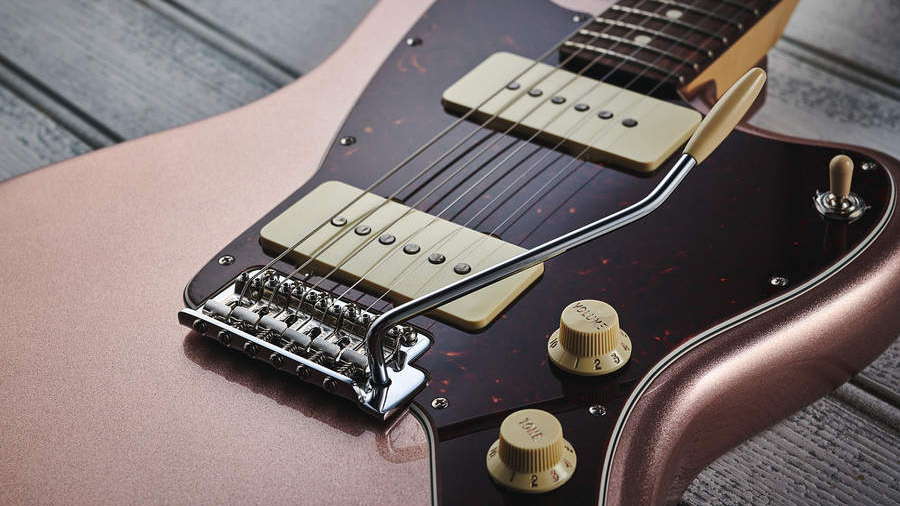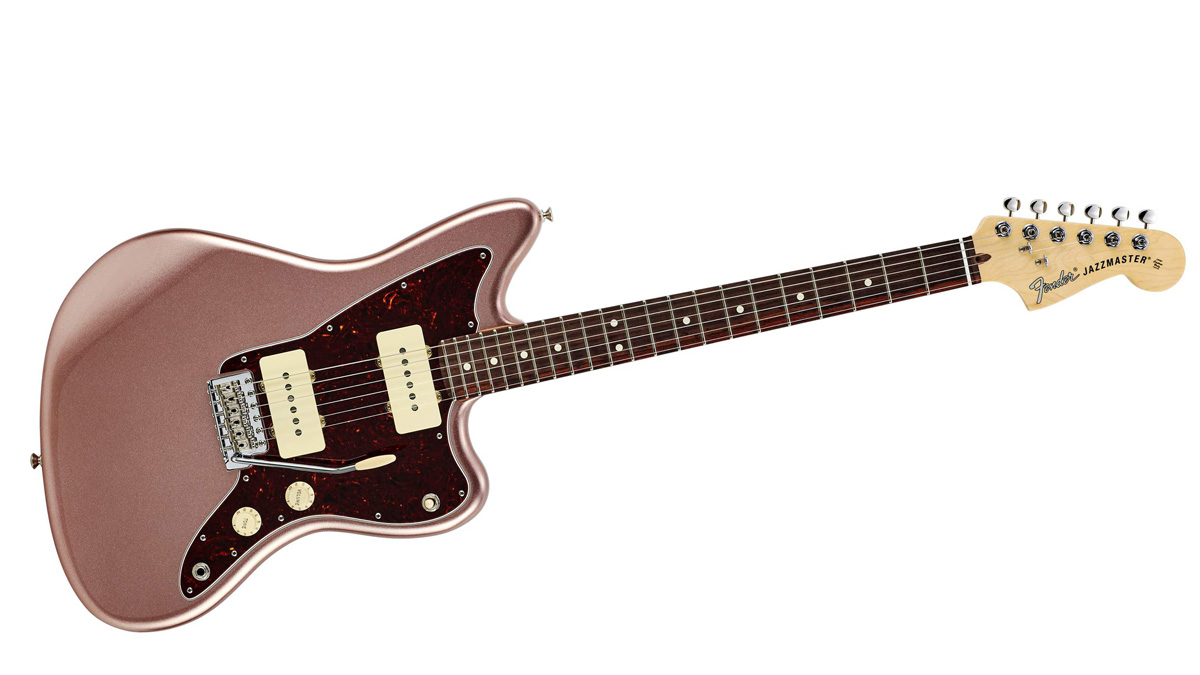MusicRadar Verdict
A guitar for everyone.
Pros
- +
Modern playability.
- +
Hi-fi vibe of the big single-coil pickups.
- +
This thing is easy on the eye, too.
Cons
- -
The Synchronized vibrato doesn’t have the curb appeal of the classic Jazzmaster whammy.
MusicRadar's got your back
It’s 1957. Fullerton, California. You’re Leo Fender. Within the last decade you and your team have invented the Esquire, Telecaster, Stratocaster, Precision Bass and the Bassman amplifier.
Your competition is floundering. Compared with the Gibson Les Paul and the Gretsch Duo Jet, your Stratocaster guitar looks like it was beamed down from a passing flying saucer. Business is brisk. But you’re Leo Fender. The Strat is already three years old! You need to stay on top. The big question is: how do you follow a guitar like that?
Fender’s response is the Jazzmaster. Released in 1958, the new model combines important Fender trademarks (bolt-on maple neck, six-on-one-side tuner layout) with a recent addition to the Fullerton factory’s spec options - a rosewood fingerboard.
The Jazzmaster is intended to be Leo’s flagship model. He regards the Tele and Strat as tools for the working musician. Now he wants to offer some luxury. The brief is a top-of-the-range looker that’ll hook the jazz cats and studio aces.
Fresh from the drawing board, the Jazzmaster is a handsome bugger and that’s no lie. The only problem is, no-one actually wants it. Where the Strat is lithe and lightweight, the Jazzmaster is a bit more cumbersome. The Strat has three pickups, its wiring loom is beautifully simple and the volume and tone controls fall easily to hand. That low-profile ‘Synchronized’ vibrato unit is a work of genius. By way of contrast, the Jazzmaster has two pickups, a complicated control layout, not to mention a spectacularly over-engineered vibrato unit and bridge setup. If Leo thinks the country jazz hotshots of the day are going to trade in their big hollowbody guitars for his latest flame, well, good luck with that.
Now, 60-odd years on, the Jazzmaster is still going strong, of course. While it never did capture the imagination of jazz players, it’s a favourite of new wave and alternative heroes such as Elvis Costello and J Mascis of Dinosaur Jr, both of whom have Jazzmaster-based signature models. This latest version, the American Performer Jazzmaster, aims to widen the model’s social circle with a simplified layout and modern playing experience. Likewise, the newest version of the much-loved Mustang, a guitar that was never intended to be anything more than a decent student guitar.

This American Performer model is built around an offset alder chassis with a hard-wearing gloss polyurethane finish. The maple necks are bolt-on, of course, and while they share a comfortable ‘Modern C’ profile, 241mm (9.5-inch) radius and satin polyurethane coating, their scale lengths differ. The Jazzmaster is your classic 648mm (25.5- inch) scale; the Mustang is short-scale at 610mm (24 inches). Other similarities include 22 jumbo frets (vintage and reissue models only have 21) and a simple wiring loom. You get a master volume, ‘Greasebucket’ tone and a three-way pickup selector toggle switch.
Want all the hottest music and gear news, reviews, deals, features and more, direct to your inbox? Sign up here.
Looking more closely at the Jazzmaster you’ll discover that the big old floating vibrato and rocking bridge chiselled into vintage and reissue models ain’t there. Fender has opted for a vintage Strat-style vibrato for the American Performer. It’s not the first time Fender has put out a Jazzmaster in this format, but it still looks a little odd. Not having the old-school floating unit taking up all that body space leaves a hell of a lot of naked real estate behind your picking hand.
Sounds
The ‘Modern C’ profile is a great one-size-fits-all option. It hits that magic sweet spot between fat and thin. Most would never consider the Jazzmaster as a lead guitar, but the big frets and modern radius ’board make it as shreddable as any other guitar. It comes strung with 0.009 to 0.046-gauge strings.
We like the satin polyurethane finish on the neck. Fender has been using this since the American Standard stuff landed back in the 80s. Yes, we’ll always have a soft spot for the gloss nitro finish on old-school JMs, but there’s no denying the satin finish offers way less friction.
The ‘Sounds’ section of this review would be way longer if the American Performer Jazzmaster had the control layouts of its ancestor. Allow us to mansplain. Original Jazzmasters had a lead and rhythm circuit. You could switch between a regular circuit with a volume, tone and three-way toggle for the bridge and neck pickups, and a ‘rhythm’ mode with roller volume and tone controls that only fed the neck pickup. The idea was you could switch between two preset tones. As previously stated, the American Performer does away with all that kerfuffle.
Running clean, you can see why the Jazzmaster’s big single coils were so popular during the early 60s surf music craze. The top-end from the Yosemite bridge single coil is spine-tingling, especially when you crank up the reverb. The neck pup maintains much of that treble response, but there’s a bit more Duane Eddy-esque depth. Switch reverb for slapback echo and the Jazzmaster makes a credible rockabilly machine. Lest we forget, one of this model’s earliest supporters was much-loved Johnny Cash sideman Luther Perkins.
Start piling on the dirt and the Jazzmaster goes all alternative rock. That sizzling top-end definition coexists beautifully with dirt and delay. You don’t necessarily have to gaze down at your shoes, but that’s the sound you’ll get.
Fender has really shown its offset throwbacks some love in the past few years what with its recently released Vintera Jazzmasters, Jaguars and Mustangs. This American Performer version isn’t quite as cute as the vintage-spec models, but it’s easier to play. After all, it’s the mad design quirks that make the original Jms so adorable, but not everyone wants that stuff.
In the end, there’s enough vintage DNA in this models to make it cool, balanced with a level of modern build quality and playability to make them accessible to all types of player. A guitar for everyone, if you will. As it happens, that’s all Leo Fender set out to achieve in the first place.
